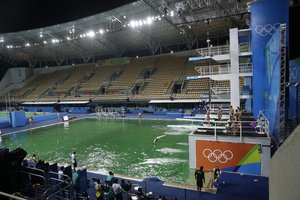- published: 02 Sep 2015
- views: 333
-
remove the playlistTopographic Prominence
-
remove the playlistLatest Videos
-
remove the playlistLongest Videos
- remove the playlistTopographic Prominence
- remove the playlistLatest Videos
- remove the playlistLongest Videos
- published: 13 Aug 2015
- views: 37913
- published: 26 May 2016
- views: 63
- published: 19 Mar 2013
- views: 77
- published: 27 Jun 2014
- views: 16
- published: 26 Sep 2013
- views: 35

Topographic prominence
In topography, prominence characterizes the height of a mountain or hill's summit by the vertical distance between it and the lowest contour line encircling with no higher summit. It is a measure of the independence of a summit. A peak's key col is a unique point on this contour line and the parent peak is some higher mountain, selected according to various objective criteria.
Definitions
By convention, the prominence of Mount Everest, the Earth's highest mountain, is taken to equal the elevation of its summit above sea level. Apart from this special case, there are several equivalent definitions:
This article is licensed under the Creative Commons Attribution-ShareAlike 3.0 Unported License, which means that you can copy and modify it as long as the entire work (including additions) remains under this license.

Denali
Denali /dᵻˈnɑːli/ (also known as Mount McKinley, its former official name) is the highest mountain peak in North America, with a summit elevation of 20,310 feet (6,190 m) above sea level. At some 18,000 ft (5,500 m), the base-to-peak rise is the largest of any mountain situated entirely above sea level. With a topographic prominence of 20,156 feet (6,144 m) and a topographic isolation of 4,629 miles (7,450 km), Denali is the third most prominent and third most isolated peak after Mount Everest and Aconcagua. Located in the Alaska Range in the interior of the U.S. state of Alaska, Denali is the centerpiece of Denali National Park and Preserve.
The Koyukon people who inhabit the area around the mountain have referred to the peak as "Denali" for centuries. In 1896, a gold prospector named it "Mount McKinley" in support of then-presidential candidate William McKinley; that name was the official name recognized by the United States government from 1917–2015. In August 2015, following the 1975 lead of the state of Alaska, the U.S. Department of the Interior announced the change of the official name of the mountain to Denali. Prior to this, most Alaskans already referred to the mountain as Denali.
This article is licensed under the Creative Commons Attribution-ShareAlike 3.0 Unported License, which means that you can copy and modify it as long as the entire work (including additions) remains under this license.
- Loading...

-
 2:26
2:26Topographic prominence - Video Learning - WizScience.com
Topographic prominence - Video Learning - WizScience.comTopographic prominence - Video Learning - WizScience.com
In topography, "prominence" characterizes the height of a mountain or hill's summit by the vertical distance between it and the lowest contour line encircling with no higher summit. It is a measure of the independence of a summit. A peak's "key col" is a unique point on this contour line and the "parent peak" is some higher mountain, selected according to various objective criteria. By convention, the prominence of Mount Everest, the Earth's highest mountain, is taken to equal the elevation of its summit above sea level. Apart from this special case, there are several equivalent definitions: Prominence is interesting to some mountaineers because it is an objective measurement that is strongly correlated with the subjective significance of a summit. Peaks with low prominences are either subsidiary tops of some higher summit or relatively insignificant independent summits. Peaks with high prominences tend to be the highest points around and are likely to have extraordinary views. Only summits with a sufficient degree of prominence are regarded as independent mountains. For example, the world's second highest mountain is K2 . While Mount Everest's South Summit is taller, it is not considered an independent mountain because it is a subsummit of the main summit . Many lists of mountains take topographic prominence as a criterion for inclusion, or "cutoff". John and Anne Nuttall's "The Mountains of England and Wales" uses a cutoff of 15 m , and Alan Dawson's list of Marilyns uses 150 m . In the contiguous United States, the famous list of "fourteeners" uses a cutoff of 300 ft / 91 m . Also in the U.S., 2000 feet of prominence has become an informal threshold that signifies that a peak has major stature. Lists with a high topographic prominence cutoff tend to favour isolated peaks or those that are the highest point of their massif; a low value, such as the Nuttalls', results in a list with many summits that may be viewed by some as insignificant. Wiz Science™ is "the" learning channel for children and all ages. SUBSCRIBE TODAY Disclaimer: This video is for your information only. The author or publisher does not guarantee the accuracy of the content presented in this video. USE AT YOUR OWN RISK. Background Music: "The Place Inside" by Silent Partner (royalty-free) from YouTube Audio Library. This video uses material/images from https://en.wikipedia.org/wiki/Topographic+prominence, which is released under Creative Commons Attribution-Share-Alike License 3.0 http://creativecommons.org/licenses/by-sa/3.0/ . This video is licensed under Creative Commons Attribution-Share-Alike License 3.0 http://creativecommons.org/licenses/by-sa/3.0/ . To reuse/adapt the content in your own work, you must comply with the license terms. -
 50:22
50:22The Coldest Mountain | Mount McKinley Expedition - NatGeo TV
The Coldest Mountain | Mount McKinley Expedition - NatGeo TVThe Coldest Mountain | Mount McKinley Expedition - NatGeo TV
Mount McKinley or Denali (see Naming section below) is the highest mountain peak in North America, with a summit elevation of 20,237 feet (6,168 m) above sea level. At some 18,000 feet (5,500 m), the base-to-peak rise is considered the largest of any mountain situated entirely above sea level. Measured by topographic prominence, it is the third most prominent peak after Mount Everest and Aconcagua. Located in the Alaska Range in the interior of the U.S. state of Alaska, McKinley is the centerpiece of Denali National Park and Preserve. Read More: https://en.wikipedia.org/wiki/Mount_McKinley -
 6:30
6:30Prominence Vs Operator Thogar Blackrock Foundry Heroic
Prominence Vs Operator Thogar Blackrock Foundry HeroicProminence Vs Operator Thogar Blackrock Foundry Heroic
Description -
 6:27
6:27Prominence Vs Jin'rokh the Breaker HC |Throne of Thunder|
Prominence Vs Jin'rokh the Breaker HC |Throne of Thunder| -
 7:32
7:32Climbing Mount Rainier - Mount Rainier National Park
Climbing Mount Rainier - Mount Rainier National ParkClimbing Mount Rainier - Mount Rainier National Park
Mount Rainier is the 5th highest mountain, and the single most impressive mountain in my opinion, in the contiguous United States. If you have ever seen Rainier you know how impressive it is. It can be seen from 150 miles away. Columbia Crest, the highest peak on Rainier at 14,410 feet, is the highest point in Washington State. Its impressiveness is due primarily to its topographic prominence. Topographic prominence is measured from a mountains peak to the lowest contour line that would not encircle a higher peak. Prominence is very important in determining whether a peak is significant, otherwise every insignificant rock on a mountain could be considered a separate peak. Therefore, only summits with a significant degree of prominence are regarded as independent mountains. Rainier has a prominence of 13,210 ft. (4,026 m) and is the 21st most prominent mountain on Earth. For an idea of how impressive that is, K2 the world’s second highest mountain ranks in at 22nd on the list with a prominence of 13,189 ft. (4,020 m). Mount Rainier is enormous. Rainier is ranked second in the contiguous United States to the northern California peak, Mount Shasta (14,162 ft./4317 m) in terms of total volume. Its bulk and its location allow it to contain the most glaciers of any mountain in the contiguous United States with 26 as well as permanent snowfields. For this reason Rainier has been used as a training ground by people preparing to attempt the worlds other great mountains. I choose to climb with mountain guiding company since I had no experience with glacier travel, crevasse rescue, etc. I climbed with RMI, but I am sure any of the other companies that guide on the mountain would be just as good (AAI and IMG). I would suggest that if you aren’t climbing with a guide and you are inexperienced, at least someone in your party should know what in the hell they are doing. If climbing Rainier is something that you are interested in doing, there is no time like the present, because it literally might not be there if you wait. Route: Disappointment Cleaver National Park Service – Mount Rainier: http://www.nps.gov/mora/index.htm Wikipedia: https://en.wikipedia.org/wiki/Mount_Rainier Mount Rainier National Park: https://www.nps.gov/mora/index.htm RMI: https://www.rmiguides.com/ Peakbagger: http://www.peakbagger.com/peak.aspx?pid=2296 SOME DREAM, SOME DO, FEW DO BOTH -
 4:36
4:36Prominence Vs Dark Animus Normal |Throne of Thunder|
Prominence Vs Dark Animus Normal |Throne of Thunder|Prominence Vs Dark Animus Normal |Throne of Thunder|
Prominence EU Dun Modr Pov: Holy Paladin Tracklist: - TwoThirds & Feint - Epiphany (ft. Veela) -
 10:41
10:41Prominence Vs Twin Consorts 10Man Heroic
Prominence Vs Twin Consorts 10Man Heroic -
 3:35
3:35Original rap by Prominence
Original rap by ProminenceOriginal rap by Prominence
This is prominence working on my first ever song tell me what you think -
 6:30
6:30Prominence vs. General Typhiria
Prominence vs. General TyphiriaProminence vs. General Typhiria
Rift Guild: Prominence Server: Hilol Finally got off my ass and got around to making a video of our guilds kill. Not our first kill, but a kill none the less. Music by: Straight Line Stitch - Conversion Atreyu - An Interlude -
 2:09
2:09SO CRAZY by Prominence
SO CRAZY by Prominence
-

Topographic prominence - Video Learning - WizScience.com
In topography, "prominence" characterizes the height of a mountain or hill's summit by the vertical distance between it and the lowest contour line encircling with no higher summit. It is a measure of the independence of a summit. A peak's "key col" is a unique point on this contour line and the "parent peak" is some higher mountain, selected according to various objective criteria. By convention, the prominence of Mount Everest, the Earth's highest mountain, is taken to equal the elevation of its summit above sea level. Apart from this special case, there are several equivalent definitions: Prominence is interesting to some mountaineers because it is an objective measurement that is strongly correlated with the subjective significance of a summit. Peaks with low prominences are eit... -

The Coldest Mountain | Mount McKinley Expedition - NatGeo TV
Mount McKinley or Denali (see Naming section below) is the highest mountain peak in North America, with a summit elevation of 20,237 feet (6,168 m) above sea level. At some 18,000 feet (5,500 m), the base-to-peak rise is considered the largest of any mountain situated entirely above sea level. Measured by topographic prominence, it is the third most prominent peak after Mount Everest and Aconcagua. Located in the Alaska Range in the interior of the U.S. state of Alaska, McKinley is the centerpiece of Denali National Park and Preserve. Read More: https://en.wikipedia.org/wiki/Mount_McKinley -

Prominence Vs Operator Thogar Blackrock Foundry Heroic
Description -

-

Climbing Mount Rainier - Mount Rainier National Park
Mount Rainier is the 5th highest mountain, and the single most impressive mountain in my opinion, in the contiguous United States. If you have ever seen Rainier you know how impressive it is. It can be seen from 150 miles away. Columbia Crest, the highest peak on Rainier at 14,410 feet, is the highest point in Washington State. Its impressiveness is due primarily to its topographic prominence. Topographic prominence is measured from a mountains peak to the lowest contour line that would not encircle a higher peak. Prominence is very important in determining whether a peak is significant, otherwise every insignificant rock on a mountain could be considered a separate peak. Therefore, only summits with a significant degree of prominence are regarded as independent mountains. Rainier ... -

Prominence Vs Dark Animus Normal |Throne of Thunder|
Prominence EU Dun Modr Pov: Holy Paladin Tracklist: - TwoThirds & Feint - Epiphany (ft. Veela) -

-

Original rap by Prominence
This is prominence working on my first ever song tell me what you think -

Prominence vs. General Typhiria
Rift Guild: Prominence Server: Hilol Finally got off my ass and got around to making a video of our guilds kill. Not our first kill, but a kill none the less. Music by: Straight Line Stitch - Conversion Atreyu - An Interlude -

Topographic prominence - Video Learning - WizScience.com
- Order: Reorder
- Duration: 2:26
- Updated: 02 Sep 2015
- views: 333
- published: 02 Sep 2015
- views: 333
The Coldest Mountain | Mount McKinley Expedition - NatGeo TV
- Order: Reorder
- Duration: 50:22
- Updated: 13 Aug 2015
- views: 37913
- published: 13 Aug 2015
- views: 37913
Prominence Vs Operator Thogar Blackrock Foundry Heroic
- Order: Reorder
- Duration: 6:30
- Updated: 19 Feb 2015
- views: 69
Prominence Vs Jin'rokh the Breaker HC |Throne of Thunder|
- Order: Reorder
- Duration: 6:27
- Updated: 21 Mar 2013
- views: 200
Climbing Mount Rainier - Mount Rainier National Park
- Order: Reorder
- Duration: 7:32
- Updated: 26 May 2016
- views: 63
- published: 26 May 2016
- views: 63
Prominence Vs Dark Animus Normal |Throne of Thunder|
- Order: Reorder
- Duration: 4:36
- Updated: 19 Mar 2013
- views: 77
- published: 19 Mar 2013
- views: 77
Prominence Vs Twin Consorts 10Man Heroic
- Order: Reorder
- Duration: 10:41
- Updated: 22 Jul 2013
- views: 30
Original rap by Prominence
- Order: Reorder
- Duration: 3:35
- Updated: 27 Jun 2014
- views: 16
- published: 27 Jun 2014
- views: 16
Prominence vs. General Typhiria
- Order: Reorder
- Duration: 6:30
- Updated: 26 Sep 2013
- views: 35
- published: 26 Sep 2013
- views: 35
SO CRAZY by Prominence
- Order: Reorder
- Duration: 2:09
- Updated: 19 May 2015
- views: 29
-

ARIANA by Prominence
Track 2 from TRTF coming at you right here ZENERGY -

Prominence Vs The Blast Furnace Blackrock Foundry Heroic
Description -

Prominence Vs Twin Ogron Mythic
Description -

rap god freestyle by Prominence
A freestyle to the song rap god -

Dark Horse katy perry freestyle by Prominence
A freestyle to dark horse -

battle scars by Prominence
A song I wrote Instrumental battle scars lupe fiasco -

Good vs right original song by Prominence
My song Good vs right
ARIANA by Prominence
- Order: Reorder
- Duration: 3:03
- Updated: 19 May 2015
- views: 23
Prominence Vs The Blast Furnace Blackrock Foundry Heroic
- Order: Reorder
- Duration: 10:35
- Updated: 13 Mar 2015
- views: 33
Prominence Vs Twin Ogron Mythic
- Order: Reorder
- Duration: 0:37
- Updated: 21 Jan 2015
- views: 35
rap god freestyle by Prominence
- Order: Reorder
- Duration: 1:57
- Updated: 21 Sep 2014
- views: 57
- published: 21 Sep 2014
- views: 57
Dark Horse katy perry freestyle by Prominence
- Order: Reorder
- Duration: 1:12
- Updated: 21 Sep 2014
- views: 20
- published: 21 Sep 2014
- views: 20
battle scars by Prominence
- Order: Reorder
- Duration: 4:14
- Updated: 21 Sep 2014
- views: 79
-

UNSOLVED MYSTERIES: Secrets of the Ice Mountains (720p)
UNSOLVED MYSTERIES playlist: https://www.youtube.com/watch?v=mH0sIjAHBVY&list;=PL5q2UbyADqFZXb_l_9bBEPLflgq7Mq7Nx -

Denali (Mount McKinley) Mountain, Alaska - Eric Nourse & David Reinhart
Mount McKinley, or Denali (Koyukon Athabaskan for "The High One", Dghelaayce'e in Ahtna) is the highest mountain peak in the United States and in North America, with a summit elevation of 20,320 feet (6,194 m) above sea level. Measured base-to-peak, it is the tallest mountain on land. Measured by topographic prominence, it is the third most prominent peak after Mount Everest and Aconcagua. Located in the Alaska Range in the U.S. state of Alaska, it is the centerpiece of Denali National Park and Preserve. http://en.wikipedia.org/wiki/Denali -

Scenic route, Serra da Estrela. Uncut version w/GPS overlays, Ducati Multistrada Pikes Peak
Uncut version, riding Portugals highest mainland road 1993m, Parque Natural da Serra da Estrela. Map: https://goo.gl/4HZJYY GPS overlays showing details such as speed, elevation, gradient, time/date, map and temperature. 10:05 1500m 13:00 Wrong way 21:35 1950m, Portugals only skiresort. Torre and the old observation. 24:00 Clouds rolling in 39:00 The town Sabugueiro Camera: Garmin Virb Elite 1080P (affiliate link to camera): http://amzn.to/1SvXjOF Bike: Ducati Multistrada 1200S Pikes Peak (affiliate link to Ducati accessories): http://amzn.to/1RTd4Ss GPS: Garmin Zumo 350 (affiliate link to GPS): http://amzn.to/1W3zHXe Thank you for watching! Serra da Estrela (Portuguese pronunciation: [ˈsɛʁɐ ðɐ (ɨ)ʃˈtɾelɐ], "Star Mountain Range") is the highest mountain range in Continental Portugal... -

Mount Olympus
Mount Olympus (/əˈlɪmpəs, oʊˈlɪm-/; Greek: Όλυμπος; also transliterated as Olympos, and on Greek maps, Oros Olympos) is the highest mountain in Greece and the second highest mountain in the Balkans. It is located in the Olympus Range on the border between Thessaly and Macedonia, between the prefectures of Pieria and Larissa, about 80 km (50 mi) southwest from Thessaloniki. Mount Olympus has 52 peaks, deep gorges, and exceptional biodiversity. The highest peak Mytikas, meaning "nose", rises to 2,917 metres (9,570 ft). It is one of the highest peaks in Europe in terms of topographic prominence. Olympus was notable in Ancient Greek Mythology as the home of the Twelve Olympians, on the Mytikas peak. Mount Olympus is also noted for its very rich flora with several species. It has been the first... -

K2
K2 (also known as Chhogori/Qogir, Ketu/Kechu, and Mount Godwin-Austen) is the second-highest mountain on Earth, after Mount Everest. It is located on the border between Baltistan, in the Gilgit--Baltistan region of northern Pakistan, and the Taxkorgan Tajik Autonomous County of Xinjiang, China. With a peak elevation of 8,611 m (28,251 feet), K2 is the highest point of the Karakoram Range and the highest point in Pakistan. K2 is known as the Savage Mountain due to the extreme difficulty of ascent and the second-highest fatality rate among the eight thousanders. For every four people who have reached the summit, one has died trying. It is more difficult and hazardous to reach the peak of K2 from the Chinese side; thus, it is usually climbed from the Pakistani side. Unlike Annapurna, the moun... -

Monte Rosa
Monte Rosa or Mont Rose is a huge ice-covered mountain in the Alps, located on the watershed between northern and southern Europe. Its main summit, named Dufourspitze in honor of the surveyor Guillaume-Henri Dufour, culminates at 4,634 metres above sea level and is followed by the three nearly equally high subsidiary summits of Nordend, Zumsteinspitze and Signalkuppe. Monte Rosa is the highest mountain of both Switzerland and the Pennine Alps and is also the second-highest mountain of the Alps and Europe outside the Caucasus. As a massif, Monte Rosa straddles the border between Switzerland and Italy, although its main summit, unlike the three lower ones, lies on the Swiss side, within the canton of Valais. Along with the Lyskamm to the south, the west side of Monte Rosa, with its enormous ...
UNSOLVED MYSTERIES: Secrets of the Ice Mountains (720p)
- Order: Reorder
- Duration: 49:44
- Updated: 20 Oct 2014
- views: 15263
- published: 20 Oct 2014
- views: 15263
Denali (Mount McKinley) Mountain, Alaska - Eric Nourse & David Reinhart
- Order: Reorder
- Duration: 20:13
- Updated: 11 Feb 2013
- views: 318
- published: 11 Feb 2013
- views: 318
Scenic route, Serra da Estrela. Uncut version w/GPS overlays, Ducati Multistrada Pikes Peak
- Order: Reorder
- Duration: 46:17
- Updated: 21 Mar 2016
- views: 102
- published: 21 Mar 2016
- views: 102
Mount Olympus
- Order: Reorder
- Duration: 36:35
- Updated: 14 Aug 2014
- views: 77
- published: 14 Aug 2014
- views: 77
K2
- Order: Reorder
- Duration: 22:20
- Updated: 14 Jul 2014
- views: 341
- published: 14 Jul 2014
- views: 341
Monte Rosa
- Order: Reorder
- Duration: 26:31
- Updated: 18 Nov 2015
- views: 19
- published: 18 Nov 2015
- views: 19
- Playlist
- Chat
- Playlist
- Chat

Topographic prominence - Video Learning - WizScience.com
- Report rights infringement
- published: 02 Sep 2015
- views: 333

The Coldest Mountain | Mount McKinley Expedition - NatGeo TV
- Report rights infringement
- published: 13 Aug 2015
- views: 37913

Prominence Vs Operator Thogar Blackrock Foundry Heroic
- Report rights infringement
- published: 19 Feb 2015
- views: 69

Prominence Vs Jin'rokh the Breaker HC |Throne of Thunder|
- Report rights infringement
- published: 21 Mar 2013
- views: 200

Climbing Mount Rainier - Mount Rainier National Park
- Report rights infringement
- published: 26 May 2016
- views: 63

Prominence Vs Dark Animus Normal |Throne of Thunder|
- Report rights infringement
- published: 19 Mar 2013
- views: 77

Prominence Vs Twin Consorts 10Man Heroic
- Report rights infringement
- published: 22 Jul 2013
- views: 30

Original rap by Prominence
- Report rights infringement
- published: 27 Jun 2014
- views: 16

Prominence vs. General Typhiria
- Report rights infringement
- published: 26 Sep 2013
- views: 35

SO CRAZY by Prominence
- Report rights infringement
- published: 19 May 2015
- views: 29
- Playlist
- Chat

ARIANA by Prominence
- Report rights infringement
- published: 19 May 2015
- views: 23

Prominence Vs The Blast Furnace Blackrock Foundry Heroic
- Report rights infringement
- published: 13 Mar 2015
- views: 33

Prominence Vs Twin Ogron Mythic
- Report rights infringement
- published: 21 Jan 2015
- views: 35

rap god freestyle by Prominence
- Report rights infringement
- published: 21 Sep 2014
- views: 57

Dark Horse katy perry freestyle by Prominence
- Report rights infringement
- published: 21 Sep 2014
- views: 20

battle scars by Prominence
- Report rights infringement
- published: 21 Sep 2014
- views: 79

Good vs right original song by Prominence
- Report rights infringement
- published: 21 Sep 2014
- views: 71
- Playlist
- Chat

UNSOLVED MYSTERIES: Secrets of the Ice Mountains (720p)
- Report rights infringement
- published: 20 Oct 2014
- views: 15263

Denali (Mount McKinley) Mountain, Alaska - Eric Nourse & David Reinhart
- Report rights infringement
- published: 11 Feb 2013
- views: 318

Scenic route, Serra da Estrela. Uncut version w/GPS overlays, Ducati Multistrada Pikes Peak
- Report rights infringement
- published: 21 Mar 2016
- views: 102

Mount Olympus
- Report rights infringement
- published: 14 Aug 2014
- views: 77

K2
- Report rights infringement
- published: 14 Jul 2014
- views: 341

Monte Rosa
- Report rights infringement
- published: 18 Nov 2015
- views: 19
Rio Olympics Diving Pool Mysteriously Turns Green
Edit WorldNews.com 10 Aug 2016U.S. Faces Real Threats From Criminals, Terrorists, Spies…And Hillary Clinton?
Edit WorldNews.com 10 Aug 2016Wants to debate ‘very badly’ with Clinton: Trump
Edit The Hindu 10 Aug 2016Alien megastructure star’s strange behaviour can’t be understood with traditional explanations, scientists say
Edit The Independent 09 Aug 2016Olympics feel far for those in the infamous City of God slum
Edit Times Union 10 Aug 2016Horizon Minerals Corp. Announces Engagement of Gold Exploration Management Inc.
Edit Stockhouse 10 Aug 2016Bahrain detains four more Shia clerics
Edit Press TV 10 Aug 2016Renovation of historic Wigan buildings completed (Wigan Council)
Edit Public Technologies 10 Aug 2016Don’t use honorary doctorate titles - NAB
Edit Graphic 10 Aug 2016Nigeria anger over blogger Abubakar Sidiq Usman's arrest
Edit Topix 10 Aug 20161823 schoolhouse moves back to its original spot atop hill, with the help of oxen
Edit Topix 10 Aug 2016What critics are saying about 'Pete's Dragon' starring Allentown's Oakes Fegley
Edit The Morning Call 10 Aug 2016Trump slams 50 officials who say they won't support him
Edit Reuters 10 Aug 2016India to launch extensive research into solar power use: Environment Minister
Edit Indian Express 10 Aug 2016Indian activist, Irom Chanu Sharmila, ends nearly 16-year hunger strike
Edit Pittsburgh Post-Gazette 10 Aug 2016- 1
- 2
- 3
- 4
- 5
- Next page »








